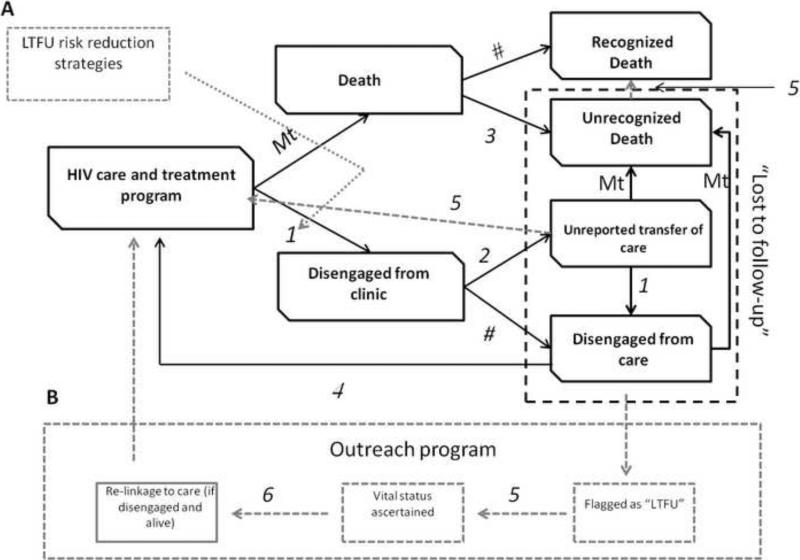Figure 1.
Conceptual model of attrition from care and re-engagement in care and an intervention portfolio designed to mitigate drop-out from clinic and care within HIV treatment programs in sub-Saharan Africa. Cohort begins in HIV care and treatment state at start of simulation and can progress to a “disengaged from clinic” (lost to follow up) state either through death without appropriate surveillance (#3 in diagram) or through lost to clinic pathway (#1 in diagram). Patients considered “lost to follow-up” as classified by health facility reside in one of three mutually exclusive health states— Unrecognized death, unreported transfer of care, or disengaged from care. Patients who are transfers are assumed to continue on ART treatment. Patients disengaged from care are assumed to be no longer compliant with ART or OI prophylaxis. Disengaged patients will return to care (#4 in diagram) if they experience a new symptomatic AIDS event. Transition probabilities between states are represented by the following abbreviations—Mt: mortality, 1: probability of disengagement from clinic; 2: probability of unreported transfer given disengagement from clinic; 3: probability of death miss-classification; 4: return to care given disengaged from care; 5: probability of being successfully traced given outreach intervention component available; 6: probability of being successfully re-linked to care given successful tracing; #: complementary probability (e.g. 1-linked probability). Note: Not all state transitions are represented on figure for purposes of readability. For example, if patients are in “unrecognized transfer state” they are exposed to same risks of death or disengagement as if they were located in original care and treatment state) Grey dotted line boxes/arrows represent components (and their effects) of interventions designed to mitigate loss from HIV treatment programs. A- includes strategies which act to reduce the likelihood that patients disengage from clinic. B- includes outreach strategy which acts to trace, ascertain status of, and re-link those patients categorized as “disengaged from care” back to health system.

